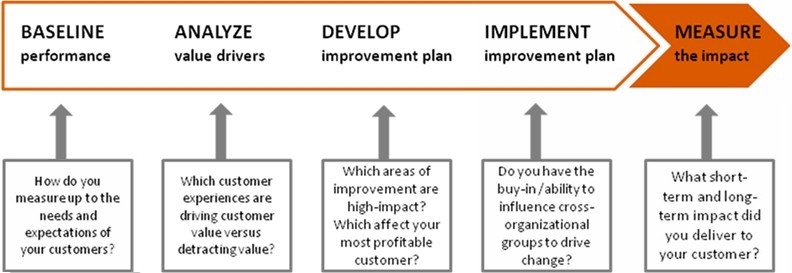Few marketers would dispute the statement that it is the sum of all customers' interactions with a company, over time, that ultimately creates or destroys that company’s brand value. Yet few companies take the time to look at their own business practices comprehensively through the lens of their customers to understand how they measure up to their customers' needs and expectations.
Does each customer interaction live up to the brand experience that the company is trying to create? Are you providing a more consistent and relevant customer experience than your competitors are? Which interactions are the most powerful for creating customer loyalty?
Fielding customer-satisfaction surveys is not enough. To better serve their customer base and more effectively acquire new customers, organizations need to delve into the details of individual interactions to understand the relationship between each customer touch point and the value it delivers to customers.
After all, value may be built through a series of positive experiences, but it is maintained through consistently meeting the needs and expectations of your customers throughout the customer lifecycle—from pre-purchase consideration to post-purchase evaluation. Companies that have recognized and leveraged this insight have reaped the benefits through improved key performance metrics. (See sidebar.)
So, despite such successes, why do so few companies take a comprehensive look at their customer touch points? And of those companies that have undertaken such initiatives, why have so many faltered?
The challenge lies in the functional silos in which most organizations operate. Customers experience your company horizontally, across organizational boundaries, but most companies approach customer interaction on a functional basis. The typical result? The inability of cross-functional teams to drive holistic change ultimately produces a disjointed experience for your customers.

Touch-point analysis uncovers powerful customer insights as well as opportunities to improve how well you meet customer-segment needs and wants. Systematically evaluating performance across all customer touch points can lead to better organizational alignment; increased brand perception; and concrete improvements in acquisition, retention, and up-sell and cross-sell efforts.
Conducting a Touch-Point Assessment
Managing your customer experience is an ongoing and evolutionary process that takes time and cross-functional commitment if it is to deliver significant results. Because customers' needs and expectations change over time, the way you meet them must evolve in accordance with those shifts.
Customer touch-point management provides a company with a critical baseline from which it can start to evaluate itself through the eyes of its customers and make small improvements to enhance the customer experience.
The approach is simple and relies on using proven process-analysis techniques to see your business through the lens of your customers. Although the process is straightforward, executing it well is far more complex. It requires listening to your customers despite receiving feedback that might challenge internal beliefs, and then aligning the organization around changes that will improve the customer experience.
The following outlines an approach to assessing and managing customer experience across all your touch points:
1. Baseline your performance
Customer touch-point projects should begin with a review of the customer insights you already have and a map of customer interactions to understand where data collection is still needed. Gather supplemental data through various research methods, such as direct interviews, short post-event surveys, etc.
The key is to ensure that the baseline assessment not only collects the relevant information on customers' needs and expectations at every stage in the customer lifecycle but also seeks to objectively measure how well each interaction adds to or subtracts from brand value. Are you delivering a consistent and relevant experience? How does a particular interaction compare with your competitors'?
2. Analyze value drivers
The next step is to analyze which interactions matter most to customers and what dimensions of those interactions drive value from a customer perspective.
Touch points with high volumes of customer interaction and those that can elicit potentially strong emotions in customers (e.g., websites, customer service, service departments) tend to have the most significant impact on your brand.
Understanding the value drivers, especially by customer segment, will help you target where to begin improving value for your customers. In doing such an analysis, ask yourself: What do my customers value in an experience? Which experiences are enhancing my relationship with my customers? How do these experiences differ by customer segment?
3. Develop and implement an improvement plan
Kicking off initiatives to improve customer experience usually requires the effort and support of several cross-functional teams. The level of buy-in across the organization to deliver a consistent brand experience will make or break your efforts.
For this reason, giving priority to a few quick wins—those that are easy to implement but will have a big impact—will help show your customers (and your internal critics) the benefits of managing the customer experience.
While mapping out the correct sequence of initiatives, ask yourself the following: What are the needs of my most-profitable segments? What impact can I deliver in the short term? In the long term? How am I going to align the organization to improve the customer experience? Who do I need buy-in from?
4. Measure the impact
The goal of touch-point analysis is to drive customer value. Measuring the improvement in customer experience and understanding movements in key performance indicators (e.g., lifetime value of the customer, retention rates, customers' willingness to recommend your brand) will help you understand how improving touch points affects loyalty, brand equity, and overall profitability of specific customer segments.
The shifts in some of these metrics will likely occur over the long term rather than immediately; therefore, they must be monitored over time.
The Customer Lens
Every organization, whether it starts with small steps or radically shifts its culture to become more customer-centric, should consider customer touch-point analysis and management as a tool to drive increased business value.
The mechanics and steps necessary to improve the customer's experience are not rocket science. The challenge comes with developing a truly objective analysis based on a company's cross-organizational boundaries and functional implications.
Companies would benefit from hiring a third party to leads the effort or developing an internal customer advocacy group to ensure that the customer is at the center of the decisions being made across the organization and to help align the organization behind the effort.
Customer touch-point analysis is akin to taking a really honest look in the organizational mirror; the face you see is not always the one you thought your customers were seeing. And that is also its greatest value: When conducted the right way, customer touch-point analysis can provide invaluable insights that serve as a catalyst for change and increase customer value.





